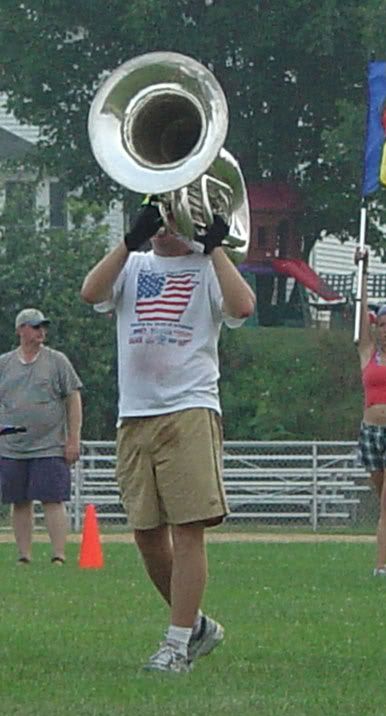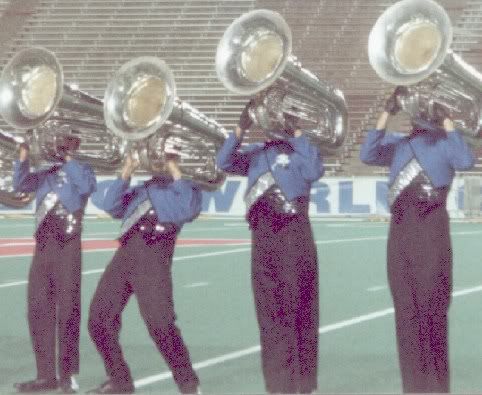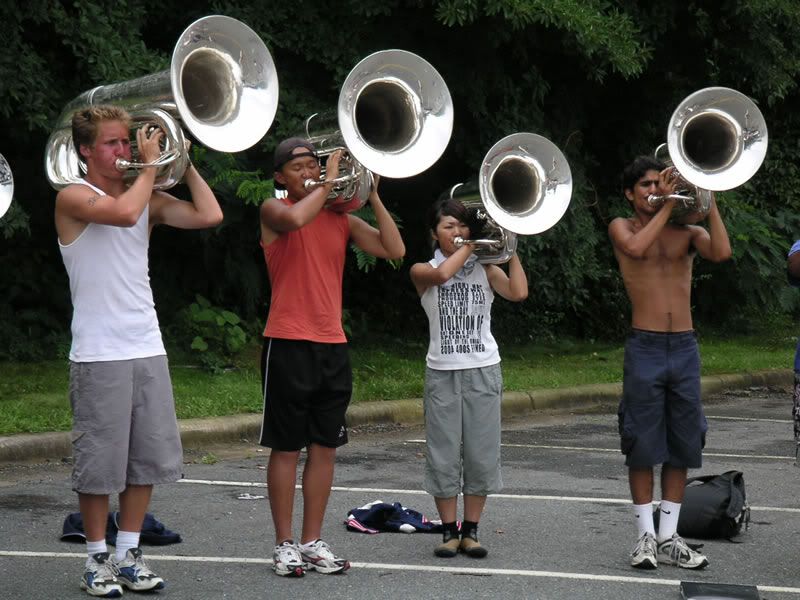Page 1 of 3
Posted: Tue Mar 21, 2006 7:58 pm
by quinterbourne
The problem is all the weight that rests on your shoulder. You will find extreme pain in your shoulder after the first day. Your body will adapt in a couple of weeks.
I wouldn't worry too much about your arms or hands (very little weight is on them, only used to balance).
Posted: Wed Mar 22, 2006 12:21 am
by Lew
quinterbourne wrote:The problem is all the weight that rests on your shoulder. You will find extreme pain in your shoulder after the first day. Your body will adapt in a couple of weeks.
I wouldn't worry too much about your arms or hands (very little weight is on them, only used to balance).
The problem isn't just the weight, but as Bloke mentioned, the hand position. I don't think that the weight on the shoulder is any worse than with a brass sousaphone. But, keeping your arm up over your shoulder for an entire half time show is bad for your blood flow. I know that I couldn't keep my arms up that long. A sousaphone's arm position is much more natural and comfortable. I think contras/convertables are just a bad idea for high school bands.
Posted: Wed Mar 22, 2006 12:31 am
by Dan Schultz
I'm glad I got through all that marching band stuff back in the days when they used REAL horns... SOUSAPHONES


Posted: Wed Mar 22, 2006 11:05 pm
by Dan Schultz
Jared wrote:
Hmmm.... is that about a $1,000 ding?
Posted: Wed Mar 22, 2006 11:15 pm
by Chuck(G)
TubaTinker wrote:Hmmm.... is that about a $1,000 ding?
Naw, that's just a "tweak" to make it play better than the factory original...
Posted: Wed Mar 22, 2006 11:25 pm
by ken k
Chuck(G) wrote:TubaTinker wrote:Hmmm.... is that about a $1,000 ding?
Naw, that's just a "tweak" to make it play better than the factory original...
sorta like dizzy gillespie's horn....
Posted: Thu Mar 23, 2006 12:12 pm
by Joe Baker
ken k wrote:Chuck(G) wrote:TubaTinker wrote:Hmmm.... is that about a $1,000 ding?
Naw, that's just a "tweak" to make it play better than the factory original...
sorta like dizzy gillespie's horn....
Yeah, but Diz bent his horn UP to play HIGHER; this one is bent DOWN to play LOWER!

___________________________________
Joe Baker, who's tried everything
else to get his low range to work, and is now trying to remember where he left that sledge hammer...

Posted: Sat Mar 25, 2006 10:14 am
by elimia
Lew wrote:quinterbourne wrote:The problem is all the weight that rests on your shoulder. You will find extreme pain in your shoulder after the first day. Your body will adapt in a couple of weeks.
I wouldn't worry too much about your arms or hands (very little weight is on them, only used to balance).
The problem isn't just the weight, but as Bloke mentioned, the hand position. I don't think that the weight on the shoulder is any worse than with a brass sousaphone. But, keeping your arm up over your shoulder for an entire half time show is bad for your blood flow. I know that I couldn't keep my arms up that long. A sousaphone's arm position is much more natural and comfortable. I think contras/convertables are just a bad idea for high school bands.
I agree. It is a shame that high school band directors try and turn their high school marching bands into little drum corps. Sousaphones are a great instrument for high school bands (and if they were considered a 'bugle', they would be superior to contras used in drum corps, in my opinion). We had a small sousaphone section in hs band (usually 4-5 people) but they had a huge sound.
Posted: Sat Mar 25, 2006 10:38 am
by LoyalTubist
Actually, the best sound we got from my high school band, marching on the street (California band review style), we used Besson uprights, just like the British bands. With the sound pointing up, it wasn't so directional and it was easier to blend with the rest of the band.

Posted: Sun Mar 26, 2006 1:31 pm
by Chuck(G)
Greg wrote:Sousaphones are the greatest instrument for marching band. But they sound like crap in a concert band. Can your local school district afford to buy a set of both tubas and sousas?
I wonder if they sound like crap because (a) the bell is pointing forward instead of off to one side or back for indoor use and (b) the same people who blat their guts out on the field are doing likewise in concert band.
A good sousaphone is a wonderful indoor instrument.
In fact, if I were a band director, I'd seriously look at buying sousaphones and having upright bells made for indoor use.
Posted: Sun Mar 26, 2006 10:49 pm
by LoyalTubist
Maybe he didn't mean he was getting contra-styled tubas...
He meant he was going to get some
Contras to assist you to give you a larger tuba section!


Posted: Mon Mar 27, 2006 10:21 pm
by LoyalTubist
Do customers (i.e., music teachers and musical performers) really control what instruments are being sold?
I think not!

Posted: Mon Mar 27, 2006 10:33 pm
by windshieldbug
Greg wrote:Chuck(G) wrote:Greg wrote:Sousaphones are the greatest instrument for marching band. But they sound like crap in a concert band. Can your local school district afford to buy a set of both tubas and sousas?
I wonder if they sound like crap because (a) the bell is pointing forward instead of off to one side or back for indoor use and (b) the same people who blat their guts out on the field are doing likewise in concert band.
A good sousaphone is a wonderful indoor instrument.
In fact, if I were a band director, I'd seriously look at buying sousaphones and having upright bells made for indoor use.
Fantastic idea. I would be in line to buy these too. Why hasn't this been done?

1898...
Posted: Mon Mar 27, 2006 10:37 pm
by Leland
Lew wrote:The problem isn't just the weight, but as Bloke mentioned, the hand position. I don't think that the weight on the shoulder is any worse than with a brass sousaphone. But, keeping your arm up over your shoulder for an entire half time show is bad for your blood flow. I know that I couldn't keep my arms up that long.
I haven't had that problem in 18 years of marching these things.
A sousaphone's arm position is much more natural and comfortable.
It is, and it isn't. I've always felt more enclosed while playing sousaphone because my right arm is so far down. When I have it higher, as on a
decently-designed marching tuba, my chest feels much less restricted.
I think contras/convertables are just a bad idea for high school bands.
As much as I prefer marching with a good contra/convertible/marching tuba, I tend to agree that sousaphones are often better for bands.
I've laid out my reasons several times before; I'll do a quick search and copy-paste what I've written already.
Heck, here's some links:
http://www.chisham.com/tips/bbs/sep2000 ... 33408.html
http://www.chisham.com/tips/bbs/nov1999 ... 17525.html
From
viewtopic.php?t=10986&highlight=contrabass
Leland wrote:Well, I really wanted to go get breakfast before heading off to work...
TECHNIQUE, TECHNIQUE, TECHNIQUE.... Strength really doesn't count for much when handling these things. I've seen some big boys have problems before they were thoroughly schooled in proper technique. Conversely, I've seen smaller and less-muscled players do very well.
If you're marching in any direction besides straight ahead, contra is a lot easier to manage. No matter how good your technique is, a sousaphone still bangs against your lower body when you're going sideways -- that just plain sucks. Putting the entire instrument above shoulder level frees up the lower body completely, and they won't interfere with each other.
Carrying flipfolders of music sucks, though. Memorize everything. It can be done -- I have over two hours' worth of performance material in my head.
I've also preferred having my arms up and away from my body; I feel closed-in when marching sousaphone.
Picking the horn up from the ground is as simple as 1-2-3:
1. Grab the outer branch, top bow, whatever you want to call it, and lift with your right hand.
2. Put your left hand on the pipes where you normally carry the horn.
3. Put your right hand at the valves.
That's standard for almost every contra-style marching tuba. The older Yamaha 201M version is a little different, but you can figure it out.
When you carry them down at your side (we call it "trail"), hold onto the big or well-braced pipes.
The most important thing for you to do when you get the horns is to spend a lot of quality time with marching fundamentals. Do balance exercises, upper-body turns, rotations while moving... anything to help reinforce the separation of your upper and lower body.
If you can get a hold of some DCI videos, especially late 80's-early 90's (because that's when they still did field-level camera angles of the horns), you'll be able to spot the good contra lines pretty easily. Copy what they do.
I've got some pictures and a couple vid clips, too.
Posted: Mon Mar 27, 2006 10:53 pm
by LoyalTubist
I hate drum and bugle corps.
(Watch the flak I get! If I said I hated marching band, no one would bat an eye!)
Posted: Mon Mar 27, 2006 11:00 pm
by Leland
<<< has better discussions to fire flack at...
(or is, "better discussions at which to fire flack"? eh...)

Posted: Mon Mar 27, 2006 11:01 pm
by windshieldbug
LoyalTubist wrote:I hate drum and bugle corps.
Too bad it's still
March!
Posted: Mon Mar 27, 2006 11:06 pm
by Chuck(G)
Leland wrote:Putting the entire instrument above shoulder level frees up the lower body completely, and they won't interfere with each other/
Doesn't have to be a covertible tuba, does it?

Posted: Mon Mar 27, 2006 11:13 pm
by LoyalTubist
I'll take a 46 Regular.
Posted: Mon Mar 27, 2006 11:18 pm
by Leland
Chuck(G) wrote:Leland wrote:Putting the entire instrument above shoulder level frees up the lower body completely, and they won't interfere with each other/
Doesn't have to be a covertible tuba, does it?

As silly as that thing looks, check out where his arms are -- that's the difference that I'm talking about.
Another couple examples (trust me, that's just my sweat!) --

I'm not in this one:

These kids aren't doing too bad:







